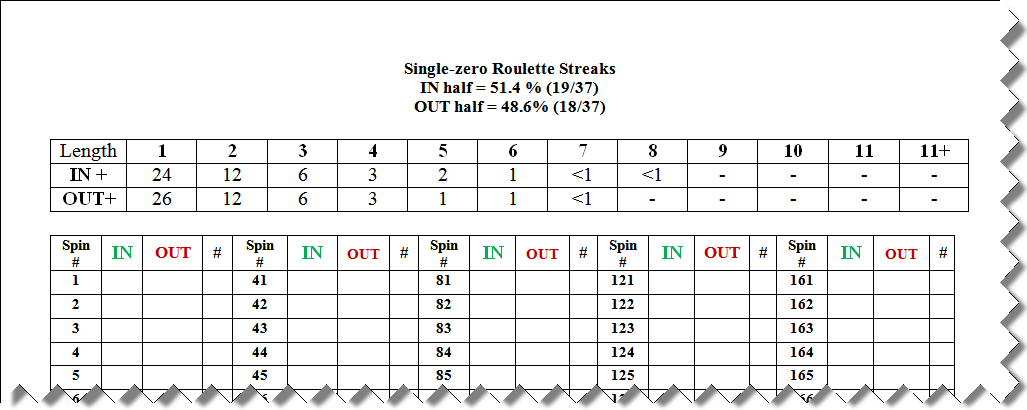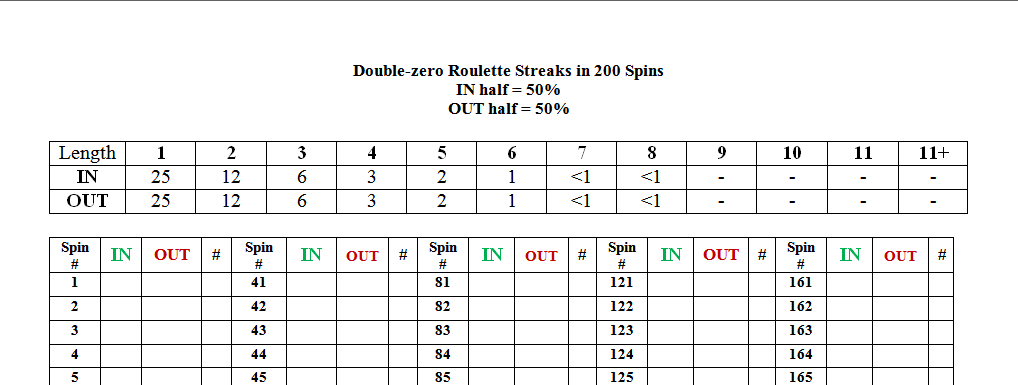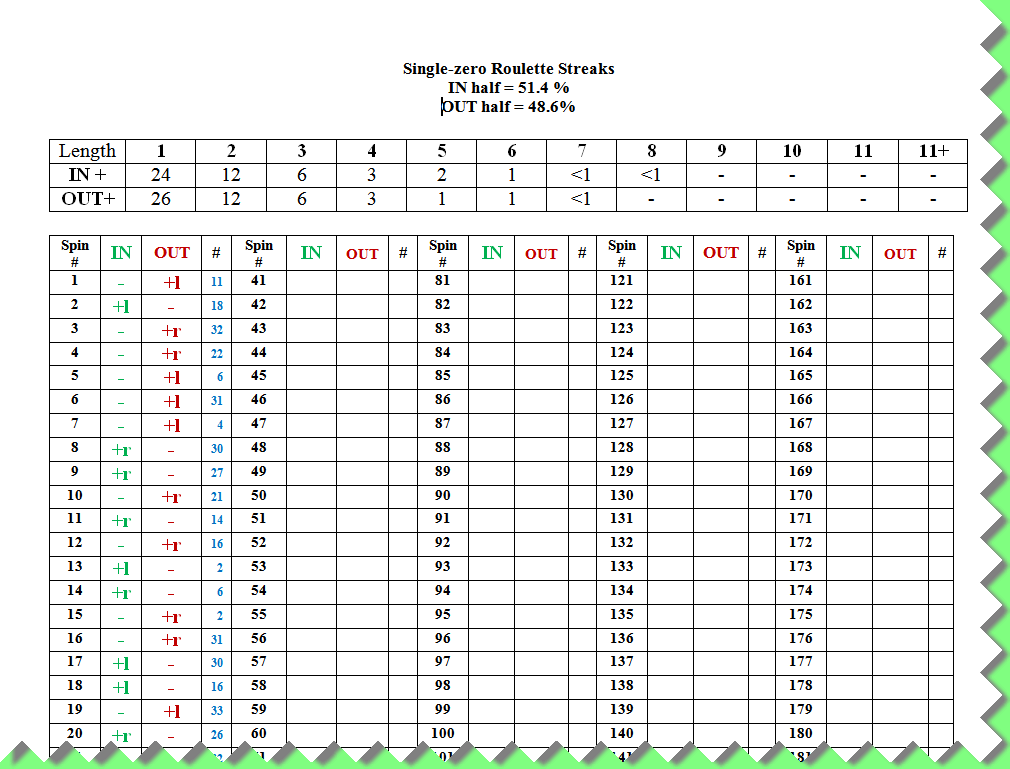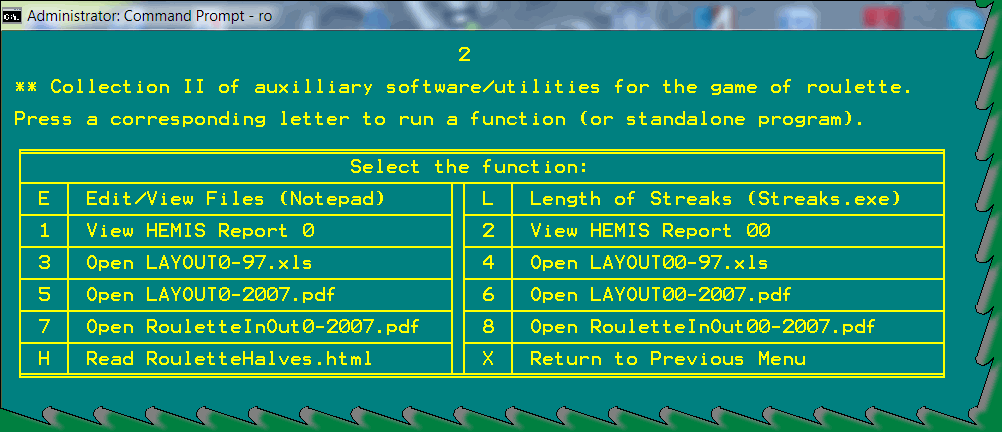
Upgrade to the Roulette System Based on Wheel Halves or Hemispheres
The original roulette system that was pirated and distributed at exorbitant prices



Published by Ion Saliu on October 21, 2010.
This entire story started by simple chance in 2000. It escalated to proportions experienced in police dramas on television. It happened at a roulette table at Taj Mahal casino, Atlantic City, in July of 2000. I noticed wheel bias regarding the jump from the previous slot to the next roulette number drawn in the next spin. Probably the deflectors of the roulette wheel were worn out. The wheel was malfunctioning, anyhow, I think.
We can divide the roulette wheel in two sections based on the last number drawn. There are 38 numbers in double-zero roulette. The last number drawn, plus 9 numbers to its left on the roulette wheel layout, plus 9 numbers to the right on the layout make up the inside hemisphere of the roulette wheel; the other 19 numbers make-up the outer hemisphere. In other words, we deal with the inner half and the outer half of a roulette wheel (since the wheel is far from being a sphere!)
The next number should be FFG-equally distributed between the two wheel hemispheres. I tracked the spins at a roulette table in Atlantic City. To my (belated) dismay, the ratio was 80% to 20% biased towards the outer hemisphere! Actually, two roulette dealers — a woman and a man — shifted at the table during that continuous run! So, it was not a so-called roulette dealer's signature! It was a malfunctioning of the roulette wheel. It was likely that the casinos had no knowledge of such phenomena. I'm sure they have now.
I wrote my in-house roulette software to analyze the distribution of numbers between the inner half and the outer half of both types of roulette wheels. I named the program RouletteHemis and I was the only user for a couple of years. Then, in the year of grace 2002 I offered a gift to one of the most intense haters of mine. The guy (you'll find him on my old message board under the alias Chip) informed me about an undocumented casino incident. Apparently, a gambler claimed he was Ion Saliu and had gambling systems for sale. I believe in reconciliation. And so I rewarded the hater of mine with free roulette software that had not been released to the public.
To my dismay, I learned from various sources and first-hand that one of the roulette systems in my gift-software had already been pirated. It always gets to me when I hear something like that: Piracy or plagiarism of my creations. I had offered the same piece of roulette software to a few other gamblers. This very roulette system was pirated soon after I introduced it.
I almost exploded in 2010! I was directed to a website named genuinewinner.com. Later on, I found out that the owner of that nest of pirates was one Steven Hourmouzis (also known as Stefano). He has a criminal record already, after committing email fraud plus securities (stock market) fraud in 2000! He, Hourmouzis – genuinewinner, sells his “system”, piracy of my roulette system based on the wheel halves, for the outrageous fee of $2,500! The guy tries his hardest to avoid specifics of “his” roulette system. But one picture is worth a thousand words. Their advertising logo reads (in an image):
"We consider which HALF of the wheel the ball landed in."
There is also a YouTube video created by the pirate, entitled: "Roulette System that Won Millions!"
The pirate does not offer software to be downloaded to the player's computer. Good thing I did not reveal the source code of my roulette program that Stefano Hourmouzis pirated in his genuinewinner roulette “system”. Boy, oh, boy! He would claim now that it's me who pirated his roulette system! As is, he has not figured out the source code of my RouletteHemis software. He secretly uses my program. The customers send him real roulette spins, table by table. Stefano Hourmouzis then runs my software to find biases at certain roulette tables. That's the reason why his users can never analyze roulette data on their own and thus discover wheel biases or not.
Evidently, I filed a number of legal complaints regarding this act of blatant piracy. A few months thereafter, in August of 2009, I observed the first effect. The Australian roulette pirate got really scared by the Law! Stefano announced at their website that he decided to stop selling his roulette system and roulette computers. Stefano already sent emails to his (their?) customers on the decision to cease selling the pirate version of one of my roulette systems. Guess how the deceived roulette customers will react!
YouTube also took action against pirate Stefano: “This video has been removed as a violation of YouTube's policy against spam, scams, and commercially deceptive content.”
You might want to read more dramatic details:

I heard that the pirated system is very hard to use, as the player does not have access to any software (unless he or she finds out that the software is actually mine and is available for free!) Initially, I had also problems trying to apply the wheel-halves roulette system in real play. I did it at home first. The roulette wheel layout is a must. The casinos still offer the layouts for free to every player. Counting the slots from the previous number drawn is no easy task, however. The player must be quick and accurate.
While fighting with this unbelievable case of piracy, I came up with great improvements to my roulette system based on the two halves of the wheel. Moreover, I added also the possibility to use the halves of the … halves! The wheel quarters can be now in play, as a betting choice.
I created special forms that can be printed in color and brought to the roulette table in any casino. I want to stress here that no casino in the world has a right, indeed legal grounds, to prohibit a casino patron from carrying and using such sheets of paper on the premises. Repeat, they are simple sheets of paper, not cheating devices of any kind, including mechanical or electronic. The user of such sheets of paper does not interfere with the game in any way whatsoever.
The most important piece is the roulette wheel layout. I created first two Excel spreadsheets, one for the single-zero roulette wheels, one for double-zero tables. I included the 1997-type Excel spreadsheet in the upgraded BrightR integrated roulette software bundle. Also, I exported the two spreadsheets to two PDF files (included in the package). The users can print as many copies as they want. Your printer must have color-printing capabilities. Shades of gray make it harder to distinguish the zones (halves). Take a look at the respective color-coded layouts:


It is very easy and quick now to determine if the current roulette number landed in the inner half or the outer half. The green zone represents the inner half (hemisphere, my favorite!), or IN. The red zone represents the outer hemisphere, or OUT. Furthermore, each half has two divisions (quarters): left and right. The pivot numbers (middle column) are sorted in ascending order, from 0 to 36 (or 37, which represents 00 on double-zero roulette wheels).
Here is an example on how it works. Suppose last roulette number was 2 (the pivot). That's the number in the middle of spreadsheet; it is also blue - colored and emphasized. You always look at the blue column in the middle. Next single-zero spin draws roulette number 0. It only takes few seconds to determine that 0 landed in the inner half (IN), compared to the pivot 2. We can be even more specific: Left IN quarter. The same scenario for double-zero roulette: 0, compared to 2, is still IN, but the in right quarter.
I created two more sheets, one for each type of roulette tables. I created a table with 40 rows to hold the roulette spins. The first column shows the sequential number of the spins (column title: Spin #). The header of the second column reads IN. The header of the third column reads OUT. The last column shows the actual roulette number drawn (column title: #). That columnar section is repeated 5 times, for a total of 200 spins on the sheet. This time, it is less important if these sheets are printed in true color or not.


Each working sheet has a very informative section created by my software, Streaks. As you know by now, everything random comes in streaks of various lengths. The frequency of a streak of a certain length is determined by mathematical formulas. The frequency is also dependent on the number of trials (roulette spins, in this case). In the single-zero roulette case, the two zones, IN and OUT are not equal. IN consists of the number in the middle, plus 18, for a total of 19 numbers (51.4%). OUT consists of 18 roulette numbers (48.6%). Streaks tells to expect an average of 24 single-length hits, or an average of 12 double-length hits in 200 roulette spins — in the IN section. A hit will be represented by the player by +; a double-length hit is represented by ++ (in columnar format, or vertically; see the working sample that follows).
In the single-zero roulette case, the two zones, IN and OUT are equal. IN consists of the number in the middle, plus 18, for a total of 19 numbers (50%). OUT consists of 19 roulette numbers (50%). Streaks tells to expect an average of 25 single-length hits, or an average of 12 double-length hits in 200 roulette spins — in the IN section. A hit will be represented by the player by +; a double-length hit is represented by ++ (in columnar format, or vertically; see the working sample that follows).
I created also a sample working sheet on how to use the data you record at the roulette table. The sample is for single-zero and is based on real casino spins from the Hamburg, Germany casino (January of 2006, 7990 spins). Filename: HAMB0106.WH1 (included in the BrightR package).

I wrote it in color for better viewing and understanding. You, the player, don't really need to work in true color. You are in a casino, and you need to act fast. But I recommend strongly that you write + for a half (section, sector, hemisphere) hit; and write immediately – (minus) in the opposing half. It makes it easier to count the streak lengths. Writing an l (for left) or r (for right) next to + can help you decide to play sometimes only one of the quarters of the hemisphere (9 or 10 numbers instead of 18 or 19).
The work flow is from the bottom to the top. The actual roulette number in spin #20 was 26. It was followed in spin #19 by roulette number 33. The result was recorded in OUT (in red) as +l (left quarter of OUT). It was followed in spin #18 by roulette number 16. The result was recorded in the IN column (in green) as +l (left quarter of IN). It was followed in spin #17 by roulette number 30. The result was recorded in IN (in green) as +l (left quarter of IN).
In real-life casino play, you will record the spins in reverse order (as compared to my working sheet). You start recording the numbers, and write +/- from top to bottom, left to right. It makes no difference. You count the + or minus signs vertically. You are interested in the length of the streaks and the number of the like-length streaks.
I did not create a new BrightR package. I only added those roulette wheel layouts and working sheets to a third screen of the package (the Auxiliary 2 section). If you open as per menu, you will be informed that you need to work with Microsoft Excel 1997 or later. Also, you need the free Adobe Reader to open PDF files. I included the XLS files (spreadsheets) for one important reason. I heard the news that the casinos added new roulette wheel layouts, in addition to the two traditional ones (French roulette and American roulette). In that case, you still have the tools to create new roulette wheel layouts accordingly.

Again, the pirated genuinewinner roulette system made it very hard to comprehend and use. The customer would send a large number of actual roulette spins to the pirate, who, in turn, would use my software to discover a bias. If there was no bias, the pirate responds that “his” system is not applicable and the user must track the results at another roulette wheel. And so on…
In my case, the user of the real roulette system based on the wheel halves — my system, that is — has also the analysis software available (free, too). RouletteHemis analyzes thousands of roulette spins in seconds. The last row of the report will show total spins in the inner half of the wheel, and total spins in the outer half. In the real case of Hamburg Spielbank for the entire month of January 2006, the bottom line was:
In that case, the roulette wheel at table 1 was biased in favor of the INner half. Here is the mathematics. The Hamburg Spielbank roulette is single-zero: A total of 37 numbers, from 0 to 36. The inner half consists of 9+9+1 = 19 numbers. The outer hemisphere (semicircle) consists of the rest of the roulette numbers: 18. Thus, the ratio between the outer half and the inner half is 18/19 = 94.7%. The statistical results should show a comparable ratio.
The analysis of the last 1000 spins (most recent) of the Hamburg Spielbank database shows an outside/inside ratio of 93.5%. The bias is 94.7 – 93.5 = 1.2% in favor of the inside half. The analysis of all 7990 spins of the Hamburg Spielbank database shows an outside/inside ratio of 90.6%. The bias is 4.87% in favor of the inside half.
Apparently, the roulette table #1 at Hamburg casino had a run when the inner hemisphere was statistically biased. The 4.87% bias is an average for the 7975 spins in the data file of Hamburg Spielbank permanenzen (7975 spins analyzed). If 1.2% was a minimum, then a maximum of over 7% occurred in any 1000 group of contiguous spins. It is possible that maximum biases larger than 7% occurred in runs shorter than 1000 roulette spins (e.g. 200 spins). Right now, the analysis in RouletteHemis starts at the top, always spin #1 (the most recent one). The last spin to be analyzed is determined by the user, and it can go all the way to the bottom (the oldest result in the data file).
Standard deviation is the watchdog of randomness. For 7990 spins, the standard deviation for the wheel outer half is 45 spins. That represents 0.6% of total spins. That is, the fluctuation should be plus or minus .6%. It is the overwhelming case of unbiased roulette wheels. The 4.87% bias falls way outside three standard deviations (1.8%)!
For 1000 spins, the standard deviation for the wheel outer half is 16 spins. That represents 1.6% of total spins. That is, the fluctuation should be plus or minus 1.6%. It is the overwhelming case of unbiased roulette wheels. The 1.2% bias falls within three standard deviations. The roulette wheel bias cases of over 7% do not. They fall way, way outside the normal probability rule!
I did some calculations for one month, that January of 2006. Playing this roulette wheel-half system with flat betting would have yielded a profit in excess of a quarter million Euros. Had the player become aware of the inner half bias of roulette table #1 at Hamburg Spielbank (by just analyzing the results on the table marquee on January 1st), he/she would have netted well over one million Euros by applying a 3-or-4-step Martingale betting.
Now, let's be aware that there is always bias. Unbiased balance between the two halves is not impossible, but it has a very, very low degree of certainty. Such degree of certainty can be calculated by applying Ion Saliu's numeric sets (exponential sets). The kind of bias registered at the roulette table #1 in Hamburg Casino might not be common at all. By the same token, there might be roulette tables with a much more skewed bias than the one above. If what I noticed at Taj Mahal lasted a month, then that bias was out of this world and the entire casino would have gone bankrupt!
Unlike the piracy, you can use this roulette system of mine immediately, without knowledge of bias. You can play it as a p = 1/2 system as described in my Super Roulette Strategy. You apply a limited-step martingale (3 or 4 steps) after 3 or 4 consecutive misses. The determining factor is table limits . Look for table limits with a ratio between minimum and maximum bets of 1 to 100 (no worse than 1 to 50). You play at low-ratio roulette tables only if you detected clear bias. But that implies long tracking sessions, hundreds of spins continuously!
While playing the p = 1/2 progression system, you might be able to determine if there is wheel bias. As in my Taj Mahal experience of 2000, the bias was detectable after 20 roulette spins or so. I would have bet more aggressively on the OUTer half of the wheel, including limited-steps martingales. I had a potential teammate that day; we could have made some big bucks the entire day, perhaps week!
How could some people be so stupid these days and pay thousands of dollars for a roulette system? We live in the Internet era. Information flows very easily around the clock and around the world. It is so easy to come across a lot of free information, including gambling theories and systems, even software.
Worse, how bad does it hurt to find out that you paid thousands of dollars for a pirated roulette system? Much worse, the original roulette system had been right at your fingertips for free!


Home | Search | New Writings | Fundamental Formula | Odds, Generator | Contents | Forums | Sitemap
